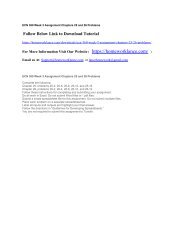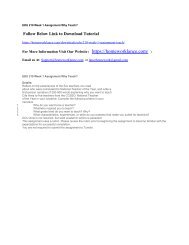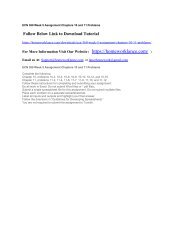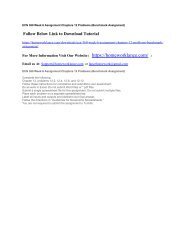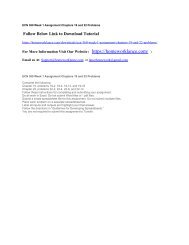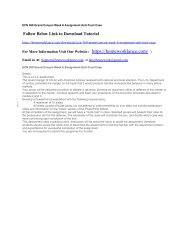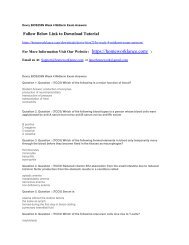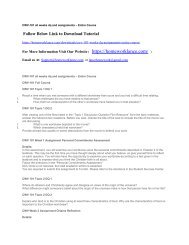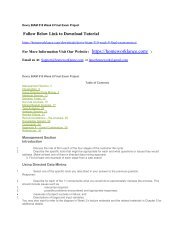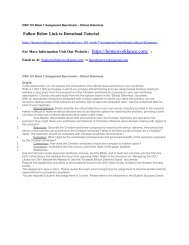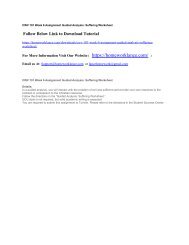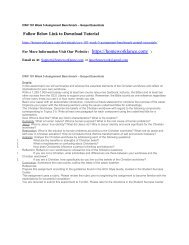Devry BIOS255 Anatomy and Physiology with Lab III – Entire Course
You also want an ePaper? Increase the reach of your titles
YUMPU automatically turns print PDFs into web optimized ePapers that Google loves.
<strong>Devry</strong> <strong>BIOS255</strong> <strong>Anatomy</strong> <strong>and</strong> <strong>Physiology</strong> <strong>with</strong> <strong>Lab</strong> <strong>III</strong> <strong>–</strong> <strong>Entire</strong> <strong>Course</strong><br />
Follow Below Link to Download Tutorial<br />
https://homeworklance.com/downloads/devry-bios255-anatomy-physiology-lab-iii-entire-course/<br />
For More Information Visit Our Website ( https://homeworklance.com/ )<br />
Email us At: Support@homeworklance.com or lancehomework@gmail.com<br />
<strong>Devry</strong> <strong>BIOS255</strong> <strong>Anatomy</strong> <strong>and</strong> <strong>Physiology</strong> <strong>with</strong> <strong>Lab</strong> <strong>III</strong> <strong>–</strong> <strong>Entire</strong> <strong>Course</strong><br />
Question<br />
The<br />
Heart<br />
(graded)<br />
The human heart is a four-chambered hydraulic pump. A hydraulic pump uses differences in pressure to move<br />
material from areas of higher pressures to areas of lower pressures. The pressure differences created by the heart<br />
move blood between the chambers <strong>and</strong> the circulatory systems. Let’s begin our discussion by identifying the<br />
chambers of the heart <strong>and</strong> their functions, the associated valves, <strong>and</strong> the names <strong>and</strong> general route of their associated<br />
great vessels.<br />
The<br />
Contraction<br />
Cycle<br />
(graded)<br />
The contraction cycle of the heart is the series of events that occurs during one heartbeat. Each beat of the heart<br />
includes the contraction (systole) <strong>and</strong> relaxation (diastole) of the atria <strong>and</strong> then the ventricles. Let’s begin the<br />
examination of this cycle by discussing electrical conduction through the heart.<br />
BIOS 255 week 2<br />
Blood<br />
Vessel<br />
Structure<br />
(graded)<br />
Let’s start by discussing the structure of our blood vessels. Let’s each take a characteristic of (1) arteries, (2) veins, or<br />
(3) capillaries. Build upon what your classmates say to enable us to have a more full underst<strong>and</strong>ing of these vessels<br />
that are essential for our existence.<br />
Blood<br />
Flow<br />
Dynamics<br />
(graded)<br />
Cardiac output is the amount of blood ejected from the left or right ventricle in any given minute. Cardiac output must<br />
be maintained in order to keep sufficient blood flow through the capillaries. Identify the factors that directly affect<br />
blood flow in the circulatory system.
BIOS 255 week 3<br />
Whole<br />
Blood<br />
(graded)<br />
Describe the composition, physical characteristics, <strong>and</strong> functions of whole blood. Explain why it is classified as a<br />
connective tissue.<br />
Liquid<br />
Connective<br />
Tissue<br />
(graded)<br />
Explain the similarities <strong>and</strong> differences among serum, lymph, <strong>and</strong> plasma. Each student should take one<br />
characteristic of the fluid, extracellular component of this connective tissue <strong>and</strong> explain how it relates to the other<br />
liquids.<br />
BIOS 255 week4<br />
The<br />
Lymphatic<br />
System<br />
(graded)<br />
How do the various components of the lymphatic system operate? We have talked about many organ systems. In<br />
what ways are components of the lymphatic system involved in many other organ systems? Try to focus on one<br />
element of this system <strong>and</strong> provide an in-depth view of its contribution to our overall health.<br />
Nonspecific<br />
Immunity<br />
(graded)<br />
How do the various elements of the nonspecific immune system function in providing daily protection against a variety<br />
of pathogens? Each student should provide a unique aspect of the nonspecific immune system <strong>and</strong> educate the rest<br />
of us concerning its function <strong>and</strong> how effective (or ineffective) it is against one class of pathogens.<br />
BIOS 255 week 5<br />
B <strong>and</strong> T<br />
Cells<br />
(graded)<br />
Our knowledge <strong>and</strong> underst<strong>and</strong>ing of the various forms of lymphocytes continue to exp<strong>and</strong>. Our initial discussion this<br />
week will be on the various forms of B <strong>and</strong> T cells — each of us should take one class of lymphocytes <strong>and</strong> explain it’s<br />
role in the adaptive immune process. As you comment on other students’ postings be sure to add additional insight<br />
into the mechanisms of the subclass of cell <strong>and</strong> its interactions <strong>with</strong> both components of the innate <strong>and</strong> other aspects<br />
of the adaptive immune system.<br />
Vaccinations<br />
<strong>–</strong> Friend or<br />
Foe (graded)<br />
Recently a number of individuals have claimed that adjuvants, such as thymersol in vaccines, lead to the<br />
development of a variety of disorders, such as autism. Although these initial claims have not been substantiated <strong>and</strong><br />
have since been <strong>with</strong>drawn from the scientific literature, the concern continues today. How would you counsel<br />
parents concerning vaccination? Discuss the issue of herd immunity <strong>and</strong> the risks in our modern society related to<br />
refusal to provide vaccinations.
BIOS 255 week 6<br />
Respiratory<br />
<strong>Anatomy</strong><br />
(graded)<br />
Describe the anatomy <strong>and</strong> histology of the respiratory system <strong>and</strong> how each of the functions are related.<br />
Breathing<br />
(graded)<br />
Describe the events that cause inhalation <strong>and</strong> exhalation <strong>and</strong> how Boyle’s law relates to the events.<br />
BIOS 255 week 7<br />
Transport<br />
of Gases<br />
(graded)<br />
Describe how oxygen <strong>and</strong> carbon dioxide are transported in the blood, <strong>and</strong> explain how their loading <strong>and</strong> unloading is<br />
affected by temperature, pH, BPG, <strong>and</strong> PCO2.<br />
Respiratory<br />
Diseases<br />
(graded)<br />
Compare the causes <strong>and</strong> consequences of chronic bronchitis, emphysema, asthma, <strong>and</strong> lung cancer. Once we have<br />
made these comparisons then we should follow up on other disorders that affect either the upper or lower respiratory<br />
systems. Be sure to comment on others postings in terms of new information that can contribute to a more complete<br />
underst<strong>and</strong>ing of the diseases you pick.<br />
<strong>Devry</strong> <strong>BIOS255</strong>N Week 4 Midterm Exam Answers<br />
Question 1. Question : (TCO3) Which of the following is a major function of blood?<br />
Student Answer: production of enzymes<br />
production of neurotransmitters<br />
transduction of pressure<br />
transportation of heat<br />
contractility<br />
Question 2. Question : (TCO3) Which of the following blood types is a person whose blood cells were<br />
agglutinated by anti-A serum but not by anti-B serum nor by anti-Rh serum<br />
B positive<br />
O negative<br />
O positive<br />
A negative<br />
Question 3. Question : (TCO3) Which of the following formed elements in blood only temporarily move<br />
through the blood before they become fixed in the tissues as macrophages?<br />
thrombocytes
monocytes<br />
basophils<br />
eosinophils<br />
Question 4. Question : (TCO3) Reduced vitamin B12 absorption from the small intestine due to reduced<br />
intrinsic factor production from the stomach results in a condition called<br />
aplastic anemia<br />
megaloblastic anemia<br />
pernicious anemia<br />
iron deficiency anemia<br />
Question 5. Question : (TCO3) Serum is<br />
plasma <strong>with</strong>out the clotting factors<br />
the same as lymph<br />
formed during the first step in blood clotting<br />
pulmonary interstitial fluid<br />
Question 6. Question : (TCO3) Which of the following precursor cells give rise to T-cells?<br />
meyloblasts<br />
lymphoid stem cells<br />
proerythroblast<br />
megakaryoblast<br />
Question 7. Question : (TCO3) Which of the following opposes the action of thromboxane A2 by inhibiting<br />
platelet adhesion <strong>and</strong> release?<br />
fibrinogen<br />
plasmin<br />
antithrombin<br />
prostacyclin<br />
Question 8. Question : (TCO3) Myeloid stem cells reside in<br />
the yellow marrow<br />
the thymus gl<strong>and</strong><br />
the red marrow<br />
the spleen<br />
Question 9. Question : (TCO1) The tough, inelastic dense connective tissue that surrounds the heart is called<br />
the<br />
pleura<br />
serous pericardium<br />
fibrous pericardium<br />
epicardium<br />
Question 10. Question : (TCO1) During heart transplants, the ______ nerves are severed resulting in a faster<br />
resting heart rate (approximately 100 beats per minute) after the transplant<br />
cardiac accelerator<br />
vagus<br />
phrenic<br />
cervical spinal<br />
Question 11. Question : (TCO1) Which of the following factors lead to depressed cardiac output?<br />
alkalosis<br />
hypoxia<br />
all of the above
none of the above have any depressive effects on the heart<br />
Question 12. Question : (TCO1) If a person’s resting heart rate is 70 <strong>and</strong> their resting stroke volume is 60 ml<br />
of blood, then their cardiac output is _______ L/min<br />
4200<br />
4.2<br />
130<br />
1.3<br />
Question 13. Question : (TCO1) The purpose of the foramen ovale during fetal life is to<br />
have the blood bypass the liver<br />
have the blood bypass the lungs<br />
have the blood bypass the placenta<br />
have the blood bypass the brain<br />
Question 14. Question : (TCO1) Heart murmurs are often heard in individuals <strong>with</strong> abnormalities in the ____<br />
of the heart.<br />
myocardium<br />
SA node<br />
AV node<br />
endocardium<br />
Question 15. Question : (TCO1) Which of the following electrocardiogram (ECG) waves represents ventricular<br />
repolarization?<br />
Q wave<br />
P wave<br />
S wave<br />
T wave<br />
Question 16. Question : (TCO1) Which part of the brain contains the cardiovascular center that regulated<br />
heart rate?<br />
cerebrum<br />
medullar oblongata<br />
cerebellum<br />
thalamus<br />
Question 17. Question : (TCO1) Which layer of the heart is comprised of epithelial cells?<br />
epicardium<br />
endocardium<br />
pericardium<br />
serous pericardium<br />
Question 18. Question : (TCO2) Which of the following categories of hypertensive drugs lower blood<br />
pressure by blocking the formation of angtiotensin II, which results in vasodilation <strong>and</strong> decreased<br />
aldosterone secretion?<br />
ACE inhibitors<br />
Beta blockers<br />
calcium channel blockers<br />
anabolic steroids<br />
Question 19. Question : (TCO2) Which of the following categories would an individual <strong>with</strong> a blood pressure<br />
of 145/95 be placed in?<br />
high normal<br />
prehypertension
stage 1 hypertension<br />
stage 2 hypertension<br />
Question 20. Question : (TCO2) Which of the following effectors would NOT be activated as described below<br />
in response to hypovolemic shock?<br />
kidneys conserve salt <strong>and</strong> water<br />
heart rate increases<br />
systemic arterioles vasodilate<br />
heart contractility increases<br />
Question 21. Question : (TCO2) Which of the following blood vessels have high pulsing blood pressure?<br />
internal jugular vein<br />
median cubital vein<br />
inferior vena cava<br />
none of the above<br />
Question 22. Question : (TCO2) During fetal development, the blood from the pulmonary veins are shunted<br />
into the pulmonary arteries by the<br />
foramen ovale<br />
ductus venosus<br />
placenta<br />
ligamentum arteriosum<br />
Question 23. Question : (TCO2) Most capillaries throughout the body are<br />
sinusoids<br />
portal systems<br />
vasoconstrictory throughputs<br />
continuous<br />
Question 24. Question : (TCO2) Capillaries are also referred to as<br />
vasoconstrictors<br />
vasodilators<br />
pressure reservoirs<br />
distributing vessels<br />
Question 25. Question : (TCO2) The volume of blood that circulates through the systemic blood vessels in<br />
one minute is called<br />
tidal volume<br />
cardiac output<br />
cardiac reserve<br />
total peripheral resistance<br />
Question 26. Question : (TCO3) What is the pulse pressure of a person that has a systolic pressure of 150<br />
mm Hg <strong>with</strong> a diastolic pressure of 90 mm Hg?<br />
Question 27. Question : (TCO3) Determine the mean arterial pressure for a patient <strong>with</strong> an average systolic<br />
pressure of 120 mm Hg <strong>with</strong> a mean diastolic pressure of 60 mm Hg:<br />
Question 28. Question : (TCO3) What is the resting cardiac output (in liters) of an athlete <strong>with</strong> a stroke<br />
volume of 75 ml <strong>and</strong> a resting heart rate of 60 beats/minute?<br />
Question 29. Question : (TCO3) The same athlete during exercise has a heart rate of 180 beats/minute <strong>with</strong> an<br />
increase of stroke volume to 125 ml. What is their cardiac output during exercise?<br />
Question 30. Question : (TCO3) What is the cardiac cycle for a person <strong>with</strong> a resting heart rate of 80 beats per<br />
minute?
Question 31. Question : TCO3) What is the name of the blood vessel that supplies the face <strong>and</strong> head (except<br />
the brain) <strong>with</strong> oxygenated blood?<br />
Question 32. Question : TCO3) What is the name of the blood vessel that is the distal extension of the<br />
external iliac artery as it enters the leg?<br />
Question 33. Question : (TCO3) What is the name of the blood vessel that drains deoxygenated blood from<br />
the medial aspect of the forearm?<br />
Question 34. Question : TCO3) What is the name of the vein that is found behind the kneecap on the<br />
posterior surface of the leg?<br />
Question 35. Question : (TCO3) What is the name of this blood vessel that is highlighted?<br />
Question 36. Question : (TCO3) List <strong>and</strong> briefly describe the three mechanisms used to reduce blood loss<br />
from a damaged blood vessel.<br />
Question 37. Question : (TCO1) Define arrhythmia <strong>and</strong> discuss different categories of arrhythmias.<br />
Question 38. Question : (TCO2) What is a portal vein? Describe the hepatic portal circulation <strong>and</strong> its<br />
functional significance<br />
<strong>BIOS255</strong> Week 1 <strong>Lab</strong> Exercise 27: Heart Structure <strong>and</strong> Function<br />
Complete the following illustrations <strong>and</strong> post it in the Week1 Dropbox.<br />
.jpg”><br />
.jpg”><br />
1. 2. 3.<br />
4. 5. 6.<br />
7. 8. 9.<br />
10.11.12.<br />
13.14.15.<br />
.jpg”><br />
.jpg”><br />
1. 2. 3.<br />
4. 5. 6.<br />
7. 8. 9.<br />
10.11.12.<br />
13.14.15.<br />
16.17.18.<br />
19.20.21.<br />
.jpg”><br />
1. 2. 3.<br />
4. 5. 6.<br />
7. 8. 9.<br />
10. 11.12.<br />
13. 14.15.<br />
16.<br />
<strong>BIOS255</strong> Week 2 <strong>Lab</strong> 2<br />
Bios 225 Week 2 <strong>Lab</strong><br />
Exercise<br />
Review of the Arteries<br />
.jpg”><br />
1. 2. 3.
4. 5. 6.<br />
7. 8. 9.<br />
10.11.12.<br />
13.14.15.<br />
16.17.18.<br />
19.20.21.<br />
22.23.24.<br />
25.26.27.<br />
28.29.30.<br />
31.32.33.<br />
34.35.36<br />
37.<br />
Review of the Veins<br />
.jpg”><br />
1. 2. 3.<br />
4. 5. 6.<br />
7. 8. 9.<br />
10.11.12.<br />
13.14.15.<br />
16.17.18.<br />
19.20.21.<br />
22.23.24.<br />
25.26.27.<br />
28.29.30.<br />
31.32.<br />
BIOS225 Week 3 <strong>Lab</strong><br />
Exercises Review of the<br />
Major Veins of the Thorax,<br />
Abdomen, <strong>and</strong> Pelvis<br />
1. 2. 3.4. 5. 6.7. 8. 9.10. 11.<br />
12.13. 14. 15.16. 17. 18.19.<br />
20.<br />
Review of Major Arteries of<br />
the Lower Limb1. 2. 3.4. 5.<br />
6.7. 8. 9.<br />
Review of Major Veins of the<br />
Lower Limb<br />
1. 2. 3.4. 5. 6.7. 8. 9.10. 11.<br />
BIOS 255 WEEK 5 <strong>Lab</strong> 5 <strong>–</strong><br />
Lymphatic System &<br />
Disease Resistance<br />
1.Describe lymphatic<br />
system functions.<br />
.jpg”<br />
alt=”LymphaticVessels2″>2.<br />
Locate each of the<br />
following lymphatic<br />
vessels:<br />
right lymphatic duct,<br />
thoracic (left lymphatic)<br />
duct,<br />
.gif”>.gif”>.gif”>right <strong>and</strong> left
subclavian veins, <strong>and</strong><br />
cisterna chyli.<br />
a<br />
b.<br />
c.<br />
d.<br />
.gif”><br />
.<br />
.jpg”<br />
alt=”BloodLymphMovement”><br />
e. Determine the direction<br />
of blood <strong>and</strong> lymph<br />
movement between<br />
arterioles, blood <strong>and</strong> lymph<br />
capillaries, <strong>and</strong> venules.<br />
f. Describe the lymphatic<br />
system role <strong>with</strong> regard to<br />
lipids <strong>and</strong> lipid-soluble<br />
vitamins.<br />
3. What are the thymus<br />
gl<strong>and</strong> functions?<br />
4. Identify each of the<br />
following in a lymph node:<br />
afferent lymphatic vessels<br />
<strong>and</strong> efferent vessels.<br />
.jpg” alt=”LymphNode”> a.<br />
.gif”>.gif”>b.<br />
c. What is the function of<br />
the macrophages <strong>with</strong>in the<br />
lymph nodes?<br />
d. Identify spleen<br />
functions..jpg” alt=”Spleen”><br />
.jpg” alt=”Cytolysis2″><br />
5. T Lymphocytes:Some<br />
activated cytotoxic T cells<br />
produce perforin. What is<br />
the function of perforin?<br />
.jpg” alt=”Lymphotoxin”><br />
6. Some activated cytotoxic<br />
T cells<br />
produce Lymphotoxin.<br />
What is the function of<br />
lymphotoxin?<br />
.jpg” alt=”Antibodies”>7.<br />
Activated B Lymphocytes<br />
are transformed into<br />
plasma cells that produce<br />
antibodies. Name five ways<br />
antibodies can destroy<br />
foreign cells <strong>and</strong><br />
substances.<br />
Bios255n week 6 ilab<br />
Acute respiratory disorder<br />
Acute respiratory disorder
BIOS 255N Week 8 Final Exam Answers <strong>–</strong> Essay Questions<br />
Question #1. Describe the feedback mechanism involved in erythropoiesis.<br />
Question #2. Describe the cardiac cycle (include conduction, contraction, heart sounds <strong>and</strong> EKG information).<br />
Question #3. Describe the factors that increase blood pressure (negative feedback involved in blood pressure<br />
regulation).<br />
Question #4. Describe the responses involved in non-specific immunity.<br />
Question #5. Describe cell-mediated immunity (antigen presentation, antigen recognition, activation <strong>and</strong> cellular<br />
response). Include both CD8 <strong>and</strong> CD4 T cells.<br />
Question #6. Describe antibody-mediated immunity (antigen presentation, antigen recognition, activation <strong>and</strong> cellular<br />
response).<br />
Question #7. Describe the events, pressures <strong>and</strong> muscles involved in inhalation <strong>and</strong> exhalation.<br />
Question #8. Describe how breathing is regulated through the negative feedback control of PCO2, PO2 <strong>and</strong> pH.




